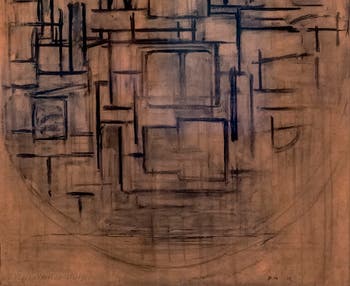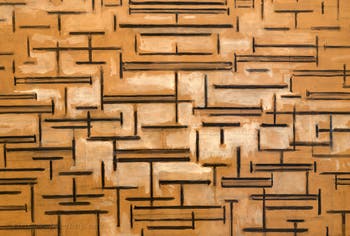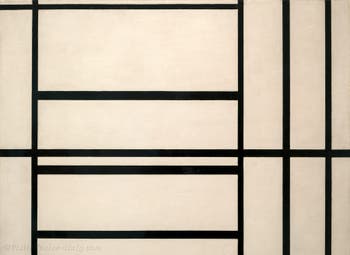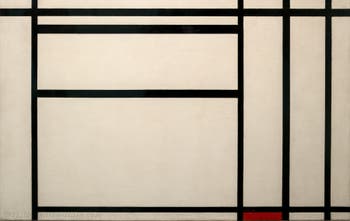Guggenheim Artists | Location | Opening Hours Tickets | Authorizations
Artists Picasso | Pollock | Braque | Calder | Chagall | Dalí | Ernst | Kandinsky | Léger | Magritte | Miró | Modigliani | Brancusi | Brauner | Campigli | Chirico | Delaunay | Delvaux | Duchamp | Fini | Hartung | Kooning | Laurens | Malevich | Man Ray | Masson | Marini | Mondrian | Pegeen | Pevsner | Picabia | Tanguy | Tapies | Twombly | Warhol
Piet Mondrian, Composition N°1 with Grey and Red, Scaffold: Study for Tableau III, Ocean 5 at the Peggy Guggenheim Collection in Venice
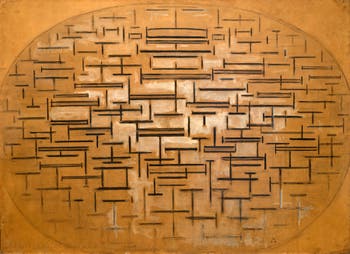
Piet Mondrian, Ocean 5
Piet Mondrian “Ocean 5” at Peggy Guggenheim Collection in Venice Italy
Painting - Charcoal and Gouache on paper (87.6 x 120.3 cm) 1915Piet Mondrian, by his real name Peter Cornelis Mondriaan, was born on March 7, 1872, in Amersfoort, Netherlands.
From 1892 to 1898, he studied art at the Rijksakademie van Beeldende Kunsten in Amsterdam.
Close to Dutch Impressionism, Piet Mondrian's early works were figurative: they represented landscapes and everyday life.
In 1909 and 1910, he experimented with pointillism.
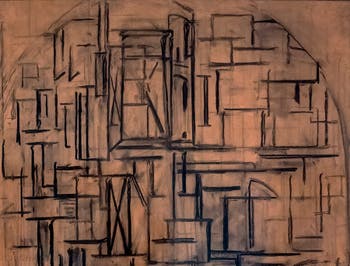
Study for Tableau III But his artistic mutation took place in 1911 after discovering Georges Braque and Pablo Picasso's works at the exhibition "Moderne Kunstkring" in Amsterdam.
Mondrian then made his first Cubist paintings.
The same year he decided to settle in Paris, where he stayed from 1912 to 1914. During this period, Piet Mondrian began to paint abstract works.
He was travelling to the Netherlands when the First World War started, which prevented him from returning to Paris.
During these years of war in Holland, Piet Mondrian's works became more and more concise, with fewer colours and simplified geometric shapes.
Then his style was defined as Non-Objective-Neo-Plastic.
In 1917 Mondrian founded the group of artists "De Stijl" with Van Doesburg and Vantongerloo.
The purpose of "De Stijl" was to extend the principles of simplification and abstraction beyond painting and sculpture.
This extension included architecture and industrial and graphic design.
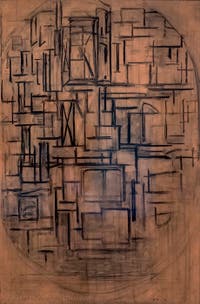
Study for Tableau III In 1925 Piet Mondrian decided to leave the group "De Stijl" when Theo Van Doesburg decided to reintroduce diagonals in his works.
The Second World War forced Mondrian to live in London, then settle in New York in October 1940.
Piet Mondrian died in the United States, New York, on February 1, 1944.
Piet Mondrian “Scaffold: Study for Tableau III” at Peggy Guggenheim Collection in Venice Italy
Charcoal on Paper (152.5 x 100 cm) 1914In his 1911 painting “Scaffold: Study for Tableau III” exhibited at the Peggy Guggenheim Collection, Cubism is ubiquitous even in the oval, but abstraction is already there.
For Mondrian, horizontal and vertical lines carry mystical meanings as opposing principles that interact to produce the symbolic union of universal harmony.
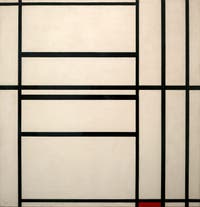
Composition 1 Grey Red
Piet Mondrian “Composition N°1 with Grey and Red” at Peggy Guggenheim Collection in Venice Italy
Oil on Canvas (105.2 x 102.3 cm) 1938-39From 1911, horizontal and vertical lines are already present in his work, took an even greater dimension in the years that followed until the extreme simplification that you can see in another of his paintings exhibited at the Peggy Guggenheim Collection: “Composition N°1 with Grey and Red” painted in 1938-39.
In this austere work, made during his stay in London, Piet Mondrian pushes to the far Reductivist Neo-Plastic approach that he had already begun to integrate while still in France.
According to Mondrian, horizontal and vertical lines now intersect asymmetrically to frame white or primary colour areas to create a dynamic effect to achieve universal harmony.
Artists Picasso | Pollock | Braque | Calder | Chagall | Dalí | Ernst | Kandinsky | Léger | Magritte | Miró | Modigliani | Brancusi | Brauner | Campigli | Chirico | Delaunay | Delvaux | Duchamp | Fini | Hartung | Kooning | Laurens | Malevich | Man Ray | Masson | Marini | Mondrian | Pegeen | Pevsner | Picabia | Tanguy | Tapies | Twombly | Warhol
Guggenheim Artists | Location | Opening Hours Tickets | Authorizations
Back to Top of Page


